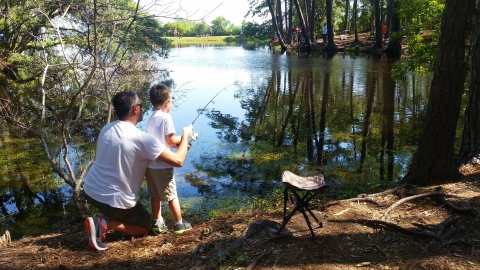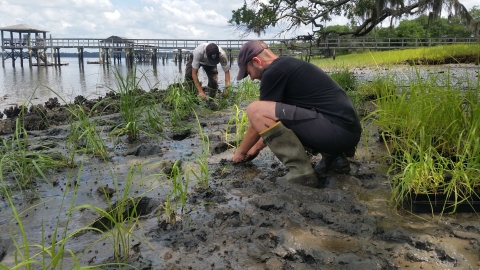What We Do
The next time you go fishing, you might just catch a fish that was raised at Bears Bluff National Fish Hatchery. Since 1871, National Fish Hatcheries have been responding to conservation challenges affecting America’s fish and other aquatic species. Producing fish continues to be an irreplaceable tool in managing and restoring fisheries along with habitat conservation. In doing so, we help provide recreation opportunities to America’s 34 million anglers who spend $36 billion annually in pursuit of their favored pastime.
Management and Conservation
Bears Bluff National Fish Hatchery is a warm-water production facility that cultures aquatic species year-round. The hatchery produces two anadromous fish species, Atlantic sturgeon and American shad, one marine fish species, red drum, one amphibian species, Carolina gopher frog, and several freshwater mussel species.
Each of these programs has its own priorities and objectives. American shad, red drum, and gopher frogs are released locally into the appropriate habitat, while the Atlantic sturgeon and mussel programs focus on conservation-oriented research, and the development of propagation and culture techniques.
Our Services
Conservation research, habitat improvement and aquaculture are some of the many management strategies used by Bears Bluff NFH biologist to help replenish populations. Our programs focus on fishery conservation efforts with Atlantic sturgeon, American shad, red drum, and imperiled freshwater mussels, as well as habitat improvement projects related to both saltmarsh and freshwater ecosystems. Since 2000, the hatchery has provided over 5 million fish to support recreational and commercial fishing, improved more than 2 miles of fish and aquatic habitat, and removed over 1000 pounds of non-native fish species in the southeast region.
Bears Bluff NFH’s work with the endangered Atlantic sturgeon has resulted in improving wild populations and an increase in the public’s awareness of the species. If you see an Atlantic sturgeon in a zoo or aquarium display, it was most likely supplied by Bears Bluff NFH.
Due to our coastal location, Bears Bluff NFH has prioritized flexibility within the Station’s objectives in order to address new and critical conservation needs of a diverse group of organisms. As a result, we are capable of producing marine fish (red drum), freshwater/anadromous fish (American shad and Atlantic sturgeon), terrestrial amphibians (gopher frogs), freshwater mussels and even some species of plants.
We also have the ability to address conservation-related research needs. We can develop and refine culture techniques for aquatic organisms, or address specific questions that advance our understanding of a species. For example, Bears Bluff NFH has developed spawning techniques for Atlantic sturgeon that produce reliable spawns annually from captive fish, and we are the only facility in the country that does this.
Our Projects and Research
National Fish Hatcheries raise fish and other aquatic species – like frogs and mussels - to help restore and sustain important fish and other aquatic species for the benefit of the American people. With declining fish and aquatic species populations becoming prevalent across the world, fish hatchery operations are more important than ever.
Atlantic Sturgeon Recovery: The Bears Bluff NFH, along with its partners, began investigating culture techniques for Atlantic sturgeon in the fall of 2008. It was then that the first wild Atlantic sturgeon was placed into captivity at Bears Bluff NFH. With the help of research partners, it took two years to acquire the six wild fish that are currently being held in captivity. These fish spawned at the hatchery for the first time in the fall of 2011 and have subsequently spawned annually since then. Bears Bluff National Fish Hatchery is the only facility in the United States that currently produces Atlantic sturgeon. The resulting offspring are distributed to cooperating scientists for research and to partners where they are publicly displayed to promote environmental awareness.
American Shad Recovery: Bears Bluff NFH made its first attempt to spawn American shad in 2008, using fish from the Santee-Cooper River system as surrogates. Each year since then, the hatchery has collected broodfish from the South Edisto River, produced fry and stocked them back into the river. Wild adult American shad are collected annually in the spring (February - May) through a collaborative electrofishing partnership with the South Carolina Department of Natural Resources (SCDNR). Broodfish are then strip spawned right on the river and fertilized eggs are brought back to the hatchery to incubate in a controlled environment. Eggs hatch after approximately five days and the fry are then immediately returned to the river. A genetic stock assessment takes place in the fall when biologist from Bears Bluff NFH and SCDNR return to the river to electrofish for out-migrating juvenile shad.
Red Drum Restoration: The red drum is a highly prized recreational sport fish and, in past years, has been considered overfished in South Carolina by the Atlantic States Marine Fisheries Commission. In 2000, Bears Bluff NFH entered into a cooperative agreement with the South Carolina Department of Natural Resources to utilize the hatchery’s ability to produce red drum for mark and recapture studies aimed at stock assessment of this marine/estuarine fish species.
Mussel Restoration and Recovery: In recent years, Bears Bluff NFH started working with imperiled freshwater mussel species, including the endangered Carolina heelsplitter mussel, Savannah lilliput mussel, and the yellow lampmussel. The hatchery is currently developing protocols for the propagation and culture of these mussel species.
Carolina Gopher Frog Restoration: The Carolina gopher frog is a species of concern and considered endangered by the state of South Carolina. Bears Bluff NFH is partnering with the SCDNR, Francis Marion National Forest, USFWS Charleston Ecological Services and the Amphibian and Reptiles Conservancy to rebuild Carolina gopher frog populations through a head-start program. Frog eggs are collected from the wild, brought back to the hatchery to hatch, and the tadpoles are then raised in protected environments until they metamorphosis into frogs. The young froglets are then transported back to where their eggs were collected and they are released into the wild.
Salt Marsh Habitat Restoration: Since 2008, Bears Bluff NFH has worked with SCDNR, private landowners and other partners around Charleston, SC to improve salt marsh salt marsh
Salt marshes are found in tidal areas near the coast, where freshwater mixes with saltwater.
Learn more about salt marsh habitat by building artificial oyster reefs and planting smooth cordgrass. Artificial oyster reefs provide a low-impact alternative to protecting the shoreline from wave action and erosion while providing valuable habitat for fish and invertebrates. Oysters are important filter feeders, maintaining water quality and protecting the shoreline by creating a barrier to wind, waves, and erosive currents. Oyster reefs, along with marsh grasses, are considered a nursery habitat for fish and invertebrates, providing food and shelter for juvenile animals. Oysters are also harvested for consumption both recreationally and commercially in South Carolina.
Native Plant Recovery: Bears Bluff National Fish Hatchery works with several species of imperiled native flora, promoting species recovery through research, collaboration with partners, propagation, rearing, and out-planting activities. Among these are the endangered American chaffseed, including host species Pityopsis sp., native pollinators such as Macbridea caroliniana and milkweed, coastal saltmarsh grass, and the Venus flytrap which is currently undergoing Species Status Assessment for potential listing under the Endangered Species Act. Native plants and seeds are collected from the wild to be propagated in the BBNFH station greenhouse, and returned to the wild. This recovery work is collaborative with the Charleston USFWS Ecological Services Field Office.



